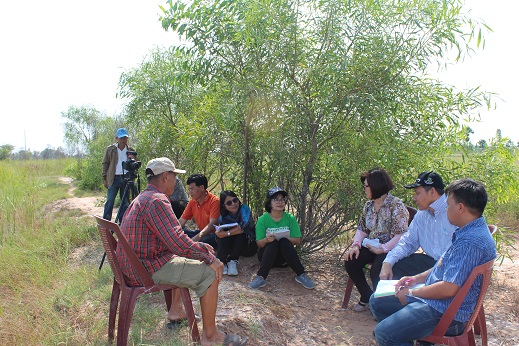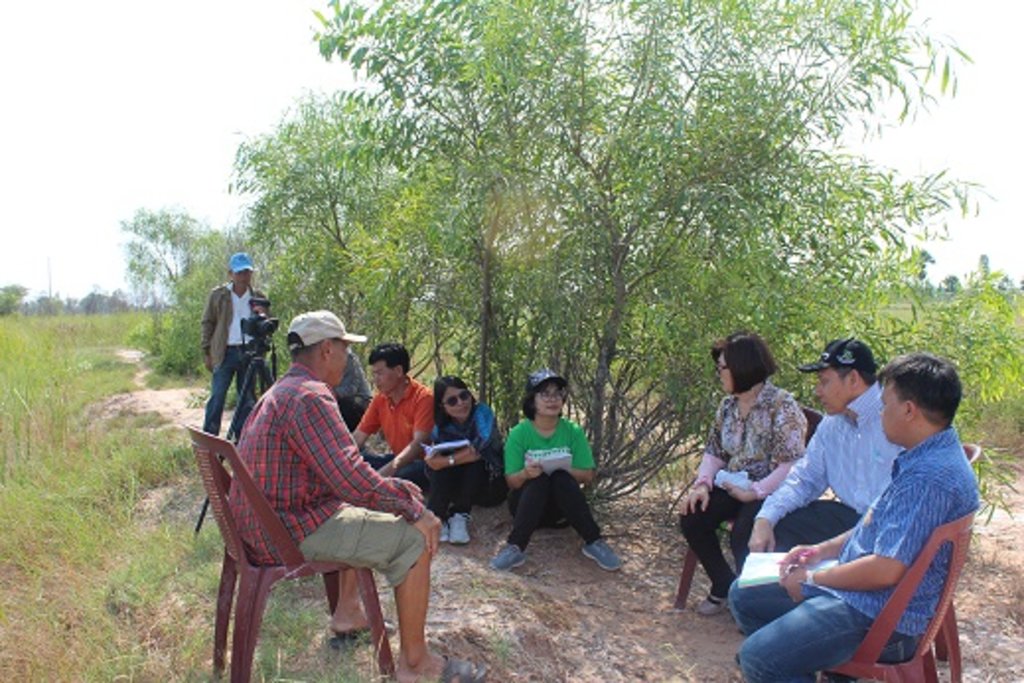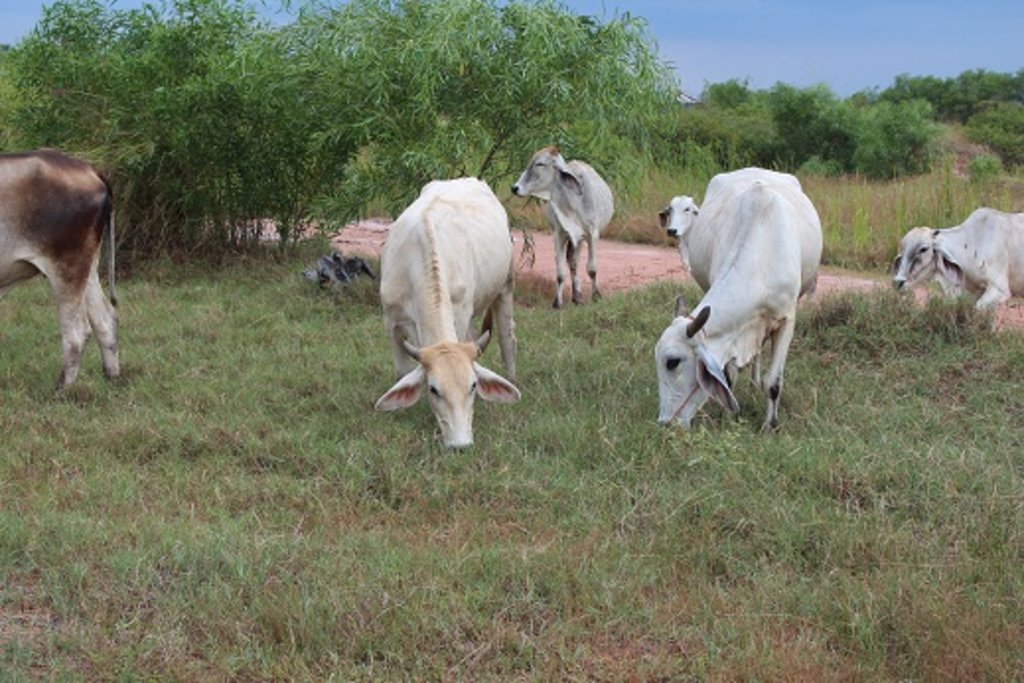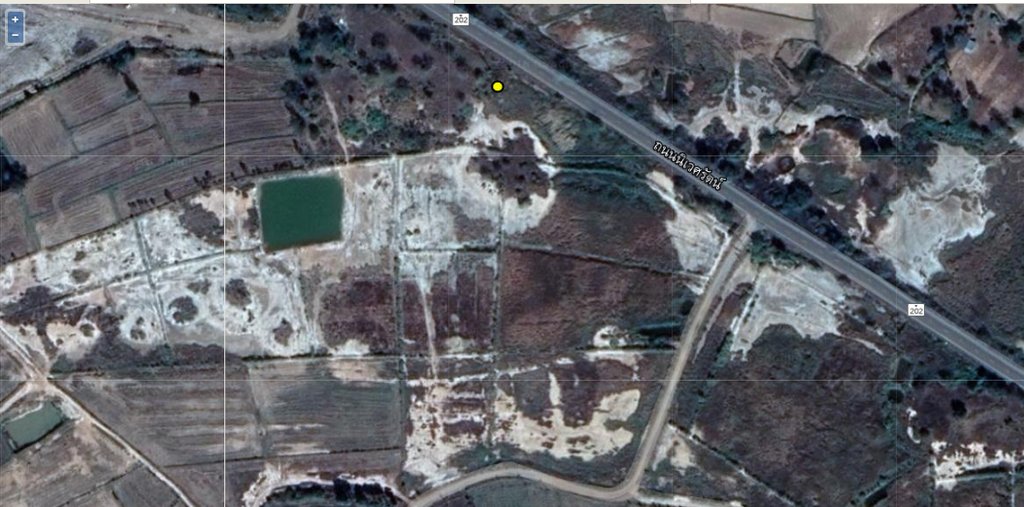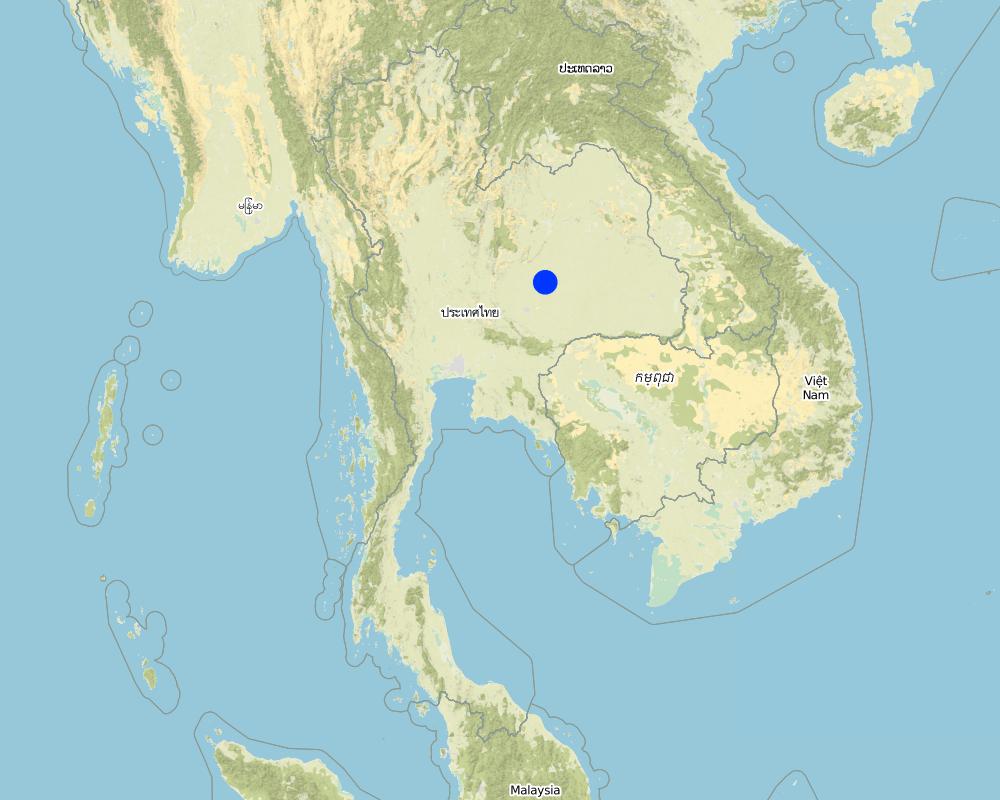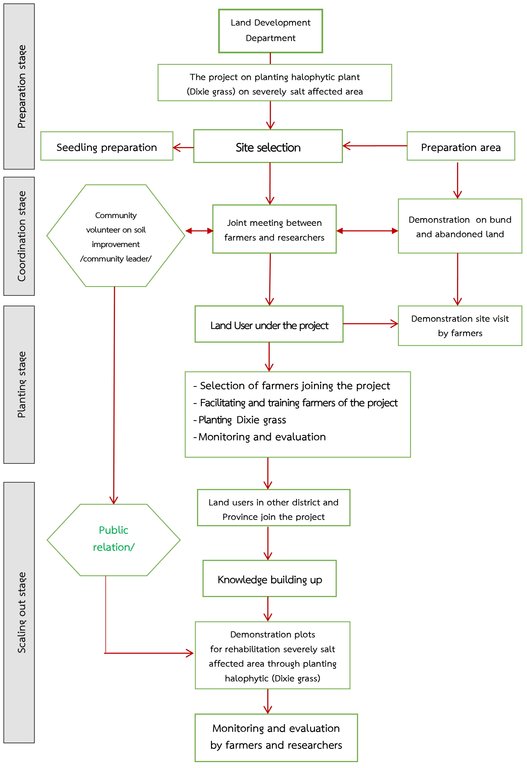Vegetative approach by using halophyte (Dixie grass) to control severely salt-affected land. [Tailândia]
- Criação:
- Atualização:
- Compilador/a: Kamontip Sasithorn
- Editor: –
- Revisores: Samran Sombatpanit, Rima Mekdaschi Studer, Alexandra Gavilano
approaches_4210 - Tailândia
Veja as seções
Expandir tudo Recolher tudo1. Informação geral
1.2 Detalhes do contato das pessoas capacitadas e instituições envolvidas na avaliação e documentação da abordagem
Pessoa(s) capacitada(s)
usuário de terra:
Yooburi Somsak
+66-80-7240599
10 Moo 12, Ban Kut Chok, Kut Chok Sub-district, Buayai District, Nakhon Ratchasima Province 30120
Tailândia
usuário de terra:
Sriwootpong Rungariam
+66-93-4613289
107 Ban Donpae Moo 8, Kut Chok Sub-district, Buayai District, Nakhon Ratchasima Province
Tailândia
Department of Agricultural Extension officer:
Auonpokang Chiwat
+66-85-7783258
Buayai District Agricultural Extension Office
49 Buayai Sub-district, Buayai District, Nakhon Ratchasima Province 30120
Tailândia
usuário de terra:
Kumtisong Noorian
+66-62-1524591
45 Moo 10, Dang-chang Sub-district, Buayai District, Nakhon Ratchasima Province 30120
Tailândia
Especialista em GST:
Especialista em GST:
Especialista em GST:
Especialista em GST:
National consultant:
Nome do projeto que facilitou a documentação/avaliação da Abordagem (se relevante)
Book project: where the land is greener - Case Studies and Analysis of Soil and Water Conservation Initiatives Worldwide (where the land is greener)Nome do projeto que facilitou a documentação/avaliação da Abordagem (se relevante)
Book project: where the land is greener - Case Studies and Analysis of Soil and Water Conservation Initiatives Worldwide (where the land is greener)Nome da(s) instituição(ões) que facilitou(ram) a documentação/avaliação da Abordagem (se relevante)
Land Development Department LDD (Land Development Department LDD) - Tailândia1.3 Condições em relação ao uso da informação documentada através de WOCAT
Quando os dados foram compilados (no campo)?
18/10/2018
O/a compilador/a e a(s) pessoa(s) capacitada(s) aceitam as condições relativas ao uso de dados documentados através da WOCAT:
Sim
1.4 Referência ao(s) questionário(s) sobre tecnologias da GST
2. Descrição da abordagem de GST
2.1 Descrição curta da abordagem
The government promotes halophytes (Dixie grass) to control severely salt-affected land, rehabilitate the ecosystem and prevent the spread of salt in soil under cooperation of land owners, livestock farmers, local administration, local government agency, Land Development Department researchers and with specialists/ technical advisors in various fields.
2.2 Descrição detalhada da abordagem
Descrição detalhada da abordagem:
Ministry of Agriculture and Cooperatives by Land Development Department (LDD) had initiated the project on planting salt-tolerant tree and grass on severely salt-affected land in the Northeast of Thailand since 1996. The project had facilitated planting halophyte (Dixie grass) on salt-crusted and barren land since then. The main objectives of approach were to promote the land users to maximize land use for farming, prevent the forming of extensive severely saline soil, to use halophyte (Dixie grass) as cover crop and rehabilitate the ecosystem of severely salt-affected soil. The activities started with public hearing, identifying severely salt-affected areas, set demonstration plot on the farmer’s land as learning center and communication with local administration to call for farmers meeting with detailed work plan and discussion of strengths, weaknesses, opportunities, and threats of planting Dixie grass. The implementing activities consisted of 4 stages; the PREPARATION STAGE was for seedling preparation, site selection of severely salt-affected soil and land preparation, public hearing and establishment of the demonstration plot at Dan Chang Sub-district, Buayai District, Nakhon Ratchasima Province. The COORDINATION STAGE included joint meeting between farmers and researchers, joint monitoring & evaluation and follow up and land users' decision-making. The PLANTING STAGE started from selection of farmers joining the project, facilitating and training farmers, site visit to the demonstration plot, which is the model of planting method established under the project on planting salt-tolerant tree and grass on severely salt-affected land in the Northeast of Thailand. The FINAL ACTIVITY OF SCALING-OUT STAGE: the land users/ farmers favoured this project; after 3 years of planting Dixie grass it was found this barren land became covered by plants and much improved in biodiversity by the evidence of many varieties of wild grasses and flowers, dragonflies, rats and birds. Farmers could now grow rice and they used Dixie grass as feed for livestock. Moreover, and attractively, farmers were able to increase their income. The migration for job to big cities was reduced. The stakeholders were land owners, livestock farmers, local administration, local government agency, researchers and SML specialists from LDD - all worked together with mutual benefit. Although planting halophytes was an improvement method (of vegetative measure) of severely saline soil with low input, the recovery/accomplishment time (in saline soil improvement) could not be as fast as that of the engineering measure with much higher investment.
2.3 Fotos da abordagem
2.4 Vídeos da abordagem
Data:
18/10/2018
Localização:
6 Ban Donpae Moo 8, Kut Chok Sub-district, Buayai District, Nakhon Ratchasima Province
2.5 País/região/locais onde a abordagem foi aplicada
País:
Tailândia
Região/Estado/Província:
Nakhon Ratchasima Province
Especificação adicional de localização:
6 Ban Donpae Moo 8, Kut Chok Sub-district, Buayai District
Map
×2.6 Datas de início e término da abordagem
Indique o ano de início:
2015
Ano de término (caso a abordagem não seja mais aplicada):
2016
2.7 Tipo de abordagem
- Baseado em projeto/programa
2.8 Principais metas/objetivos da abordagem
The main objectives of the approach were to promote the land users to maximize land use for farming, to prevent the forming of extensive severely saline soil, to use halophyte (Dixie grass) as cover crop and to rehabilitate the ecosystem of severely salt-affected soil.
2.9 Condição que propiciam ou inibem a implementação de tecnologia/tecnologias aplicada(s) segundo a abordagem
Normas e valores sociais/culturais/religiosos
- Propício
The land users follow what their neighbours practice.
Disponibilidade/acesso a recursos e serviços financeiros
- Propício
Through the Bank for Agriculture and Agricultural Cooperatives.
Quadro institucional
- Propício
Local administration
Colaboração/coordenção de atores
- Propício
Coordination of soil doctor volunteers and community leaders in the area.
Políticas
- Propício
The government has the policy to prevent soil degradation.
Conhecimento sobre GST, acesso a suporte técnico
- Propício
To provide knowledge to land users in the area.
Carga de trabalho, disponibilidade de força de trabalho
- Propício
For land users under the project
- Inibitivo
For land users outside the project
3. Participação e papel das partes interessadas envolvidas
3.1 Partes interessadas envolvidas na abordagem e seus papéis
- Usuários de terra/comunidades locais
Farmers under the project
Planting halophytes (Sporobolus verginicus - Dixie grass)
- Organizações comunitárias
Local administration (Sub-district Administration Organization)
Call for meeting
- Especialistas em GST/ consultor agrícola
Land Development Department
Site selection
- Pesquisadores
Land Development Department
Provide technical recommendations
- Governo nacional (planejadores, responsáveis pelas decisões)
Land Development Department
Funding, planner, decision-makers
3.2 Envolvimento do usuários de terra/comunidades locais nas diferentes fases da abordagem
| Envolvimento do usuários de terra/comunidades locais | Especifique quem estava envolvido e descreva as atividades | |
|---|---|---|
| Iniciação/motivação | Participativo | Land users in the project based |
| Planejamento | Passivo | Discussion with land users on work plan before starting the activity. |
| Implementação | Apoio externo | Land users/farmers in the project |
| Monitoramento/avaliação | Apoio externo | Land users in the project |
3.3 Fluxograma (se disponível)
Descrição:
Four stages of participating process of technology development among organizations, community volunteers on soil improvement, farmers, SML specialists and researchers.
Autor:
Kamontip Sasithorn
3.4 Decisão sobre a seleção de tecnologia/tecnologias de GST
Especifique quem decidiu sobre a seleção de tecnologia/tecnologias a serem implementadas:
- Principalmente especialistas em GST, após consulta com usuários da terra
Especifique em que base foram tomadas as decisões:
- Avaliação de conhecimento bem documentado de GST (tomada de decisão baseada em evidências)
4. Suporte técnico, reforço das capacidades e gestão do conhecimento
4.1 Reforço das capacidades/ formação
Foi oferecida formação aos usuários da terra/outras partes interessadas?
Sim
Especifique quem foi capacitado:
- Usuários de terra
Tipo de formação:
- Áreas de demonstração
- Reuniões públicas
Assuntos abordados:
Prevention and rehabilitation of salt-affected land with available technology and increased income for farmers.
4.2 Serviço de consultoria
Os usuários de terra têm acesso a um serviço de consultoria?
Sim
Especifique se foi oferecido serviço de consultoria:
- nas áreas dos usuários da terra
Descreva/comentários:
1. Soil doctor volunteers represent the Land Development Department with duty in providing knowledge to farmers in the area.
2. SLM specialists from Land Development Department visited and advised farmers in the area.
4.3 Fortalecimento da instituição (desenvolvimento organizacional)
As instituições foram fortalecidas ou estabelecidas através da abordagem?
- Não
4.4 Monitoramento e avaliação
Monitoramento e avaliação são partes da abordagem?
Sim
Comentários:
SLM specialists from Land Development Department collaborated with LDD soil doctor volunteers in surveying the survival rate and following up the growth of plants in the area.
Caso afirmativo, esta documentação é destinada a ser utilizada para monitoramento e avaliação?
Sim
4.5 Pesquisa
A pesquisa foi parte da abordagem?
Sim
Especifique os tópicos:
- Tecnologia
Dê mais detalhes e indique quem realizou a pesquisa:
The Soil Salinity Research Group, LDD, conducted research on "halophytes plantation and the flow path along the landscape in Northeast Thailand" with Dr. J.L. Gallagher from Delaware Biotechnology Institute, University of Delaware.
5. Financiamento e apoio material externo
5.1 Orçamento anual para o componente de GST da abordagem
Caso o orçamento exato seja desconhecido, indique a faixa:
- < 2.000
Comentários (p. ex. principais fontes de recursos/principais doadores):
Land Development Department
5.2 Apoio financeiro/material concedido aos usuários da terra
Os usuários da terra receberam apoio financeiro/material para a implementação de tecnologia/tecnologias?
Sim
Caso afirmativo, especifique tipo(s) de apoio, condições e fornecedor(es):
Dixie grass seedlings and land preparation cost
5.3 Subsídios para entradas específicas (incluindo mão-de-obra)
- Mão-de-obra
| Em que medida | Especifique os subsídios |
|---|---|
| Totalmente financiado | Planting |
- Outro
| Outros (especifique) | Em que medida | Especifique os subsídios |
|---|---|---|
| seeding | Totalmente financiado | free seedings |
Se a mão-de-obra pelos usuários da terra foi uma entrada substancial, isso foi:
- Pago em dinheiro
Comentários:
Labour by land users and employees; due to the landowner has insufficient labor for grass planting. Therefore, need to hire workers to grow by paying wages a day 175 THB/person (the minimum rate)
5.4 Crédito
Foi concedido crédito segundo a abordagem para atividades de GST?
Não
5.5 Outros incentivos ou instrumentos
Foram utilizados outros incentivos ou instrumentos para promover a implementação das tecnologias de GST?
Não
6. Análise de impactos e declarações finais
6.1 Impactos da abordagem
A abordagem concedeu autonomia aos usuários locais de terra, melhorou a participação das partes interessadas?
- Não
- Sim, pouco
- Sim, moderadamente
- Sim, significativamente
Generate food security and family income.
A abordagem propiciou a tomada de decisão baseada em evidências?
- Não
- Sim, pouco
- Sim, moderadamente
- Sim, significativamente
Establish learning center for farmers as an information for technology adoption.
A abordagem auxiliou os usuários da terra a implementar e manter as tecnologias de GST?
- Não
- Sim, pouco
- Sim, moderadamente
- Sim, significativamente
Farmers well adopted the technology, resulting in the expansion of such Approach to a wider area.
A abordagem aprimorou o conhecimento e as capacidades dos usuários da terra para implementar a GST?
- Não
- Sim, pouco
- Sim, moderadamente
- Sim, significativamente
Farmers have adapted and changed SLM model to suit their own preference.
A abordagem resultou em segurança alimentar aprimorada/nutrição melhorada?
- Não
- Sim, pouco
- Sim, moderadamente
- Sim, significativamente
Farmers can grow rice and they use Dixie grass as feed for livestock.
A abordagem resultou em emprego, oportunidades de renda?
- Não
- Sim, pouco
- Sim, moderadamente
- Sim, significativamente
The migration for job to big cities has reduced.
6.2 Principal motivação dos usuários da terra para implementar a GST
- Produção aumentada
From the interview, farmers were satisfied with this technology of Sporobolus virginicus planting to rehabilitate severely saline soil. Besides being lower in salination farmers got more rice yields and better environment and livelihoods.
- Degradação do solo reduzida
After 3 years of planting Dixie grass, it was found that the formerly barren land became covered by plants and much improved in biodiversity by the evidence of many varieties of wild grass, dragonflies, rats and birds.
6.3 Atividades de sustentabilidade de abordagem
Os usuários da terra podem manter o que foi implementado através da abordagem (sem apoio externo)?
- Sim
Caso afirmativo, descreva como:
Farmers have better understanding and positive attitude of planting halophytes (Dixie grass). Moreover, they have more income generated from rice yield and livestocks, as farmers could now grow rice and used Dixie grass to raise livestock.
6.4 Pontos fortes/vantagens da abordagem
| Pontos fortes/vantagens/oportunidades na visão do usuário da terra |
|---|
| Soil doctor volunteer, local government agency and community leader were the coordinators in the area. |
| Farmers had easy access to markets and sources of Dixie grass seedlings. |
| Distribution of Dixie grass seedling was done at no cost. |
| Pontos fortes/vantagens/oportunidades na visão do/a compilador/a ou de outra pessoa capacitada |
|---|
| A supported technique created to make better environment on severely saline soil in the Northeast of Thailand. |
| Technique in planting Dixie grass was provided continually by Land Development Department and community volunteers on soil improvement. |
| A demonstrated plot was established in the area. |
6.5 Pontos fracos, desvantagens da tecnologia e formas de superá-los
| Pontos fracos/desvantagens/riscos na visão do usuário da terra | Como eles podem ser superados? |
|---|---|
| Advertising of project was not extensive enough, particularly to the area of severely saline soil. | It is necessary for the Land Development Department to cooperate more closely with local administration to promote the project. |
| Pontos fracos/vantagens/riscos na visão do/a compilador/a ou de outra pessoa capacitada | Como eles podem ser superados? |
|---|---|
| Some farmers did not believe that Dixie grass was very salt tolerant and will make the salinity of the soil decrease after planting it. | The officers should build up knowledge from successful farmers by frequently visiting farmers in the area under the project "rehabilitation of severely salt-affected soil by planting Dixie grass". |
7. Referências e links
7.1 Métodos/fontes de informação
- entrevistas com usuários de terras
- entrevistas com especialistas em GST
7.2 Referências às publicações disponíveis
Título, autor, ano, ISBN:
Land Development Department
Disponível de onde? Custos?
http://www.ldd.go.th/
7.3 Links para informação relevante que está disponível online
Título/ descrição:
where the land is greener - Case Studies and Analysis of Soil and Water Conservation Initiatives Worldwide
URL:
https://www.wocat.net/library/media/27/
Título/ descrição:
where people and their land are safer - A Compendium of Good Practices in Disaster Risk Reduction (DRR) (where people and their land are safer) URL:
URL:
https://www.wocat.net/en/projects-and-countries/projects/drr
Links e módulos
Expandir tudo Recolher tudoLinks
Não há links
Módulos
Não há módulos


